Hyundai Sonata 2020 Owner's Manual

OWNER’S MANUAL
Operation
Maintenance
Specifications
All information in this Owner’s Manual is current at the time of publication. However, HYUNDAI reserves the right to make changes at any time so that our policy of continual product improvement may be carried out.
This manual applies to all HYUNDAI models and includes descriptions and explanations of optional as well as standard equipment. As a result, you may find material in this manual that does not apply to your specific vehicle.

Introduction
CAUTION: MODIFICATIONS TO YOUR HYUNDAI
Your HYUNDAI should not be modified in any way. Such modifications may adversely affect the performance, safety or durability of your HYUNDAI and may, in addition, violate conditions of the limited warranties covering the vehicle. Certain modifications may also be in violation of regulations
established by the U.S. Department of Transportation and other federal or state agencies.
TWO-WAYRADIOORCELLULAR
TELEPHONE INSTALLATION
Your vehicle is equipped with electronic fuel injection and other electronic components. It is possible for an improperly installed/adjusted two-way radio or cellular telephone to adversely affect electronic systems. For this reason, we recommend that you carefully follow the radio manufacturer’s instructions or consult your HYUNDAI dealer for precautionary measures or special instructions if you choose to install one of these devices.
SAFETY AND VEHICLE DAMAGE WARNING
This manual includes information titled as DANGER, WARNING, CAUTION and NOTICE.
titles indicate the following:
DANGER
indicates a hazardous situation which, if not avoided, will result in or serious injury.
WARNING
indicates a hazardous situation which, if not avoided, could result or serious injury.
CAUTION
CAUTION indicates a hazardous situation which, if not avoided, could result in minor or moderate injury.
NOTICE
NOTICE indicates a situation which, if not avoided, could result in vehicle damage.
F2

HYUNDAI VEHICLE OWNER PRIVACY POLICY
Your Hyundai vehicle may be equipped with technologies and services that use information collected, generated, recorded or stored by the vehicle. Hyundai has created a Vehicle Owner Privacy Policy to explain how these technologies and services collect use and share this information.
You may read our Vehicle Owner Privacy Policy on the Hyundaiusa.com website at: https://www.hyundaiusa.com/owner-privacy-policy.aspx
If you would like to receive a hard copy of our Vehicle Owner Privacy Policy, please contact our Customer Connect Center at:
Hyundai Customer Care P.O. Box 20850
Fountain Valley, CA 92728 800-633-5151 consumeraffairs@hmausa.com
Hyundai’s Customer Connect Center representatives are available Monday through Friday,
between the hours of 5:00 AM and 7:00 PM PST and Saturday and Sunday between 6:30 AM and 3:00 PM PST (English).
For Customer Connect Center assistance in Spanish or Korean, representatives are available Monday through Friday between 6:30 AM and 3:00 PM PST.
F3

Table of Contents
Foreword
Vehicle Information
Seats & Safety System
Instrument Cluster
Convenient Features
While Driving
Emergency Situations
Maintenance
Index
1
2
3
4
5
6
7
8
I
1. Foreword
|
|
|
|
.....................................................................................................Introduction |
1-2 |
|
|
Hyundai Motor America.................................................................................. |
1-2 |
|
|
1 |
|||
Guide to Hyundai Genuine Parts |
1-3 |
||
|
|||
How to Use This Manual................................................................................. |
1-4 |
|
|
..............................................................................................Safety Messages |
1-4 |
|
|
Fuel Requirements.......................................................................................... |
1-5 |
|
|
Vehicle Modifications...................................................................................... |
1-7 |
|
|
Vehicle Break-In Process................................................................................. |
1-7 |
|
|
Vehicle Data Collection and Event Data Recorders..................................... |
1-8 |
|

Foreword
INTRODUCTION
Congratulations, and thank you for choosing HYUNDAI. We are pleased to welcome you to the growing number of discerning people who drive HYUNDAIs. We are very proud of the advanced engineering and high-quality construction of each HYUNDAI we build.
Your Owner’s Manual will introduce you to the features and operation of your new HYUNDAI. To become familiar with your new HYUNDAI, so that you can fully enjoy it, read this Owner’s Manual carefully before driving your new vehicle.
This manual contains important safety information and instructions intended to familiarize you with your vehicle’s controls and safety features so you can safely operate your vehicle.
This manual also contains information on maintenance designed to enhance safe operation of the vehicle. It is recommended that all service and maintenance on your car be performed by an authorized HYUNDAI dealer. HYUNDAI dealers are prepared to provide high-quality service, maintenance and any other assistance that may be required.
This Owner’s Manual should be considered a permanent part of your vehicle, and should be kept in the vehicle so you can refer to it at any time. The manual should stay with the vehicle if you sell it to provide the next owner with important operating, safety and maintenance information.
HYUNDAI MOTOR AMERICA
 CAUTION
CAUTION
Severe engine and transmission damage may result from the use of poor quality fuels and lubricants that do not meet HYUNDAI specifications. You must always use high quality fuels and lubricants that meet the specifications listed on Page 2-11 in the Vehicle Specifications section of the Owner’s Manual.
Copyright 2019 HYUNDAI Motor America. All rights reserved. No part of this publication may be reproduced, stored in any retrieval system or transmitted in any form or by any means without the prior written permission of HYUNDAI Motor America.
1-2
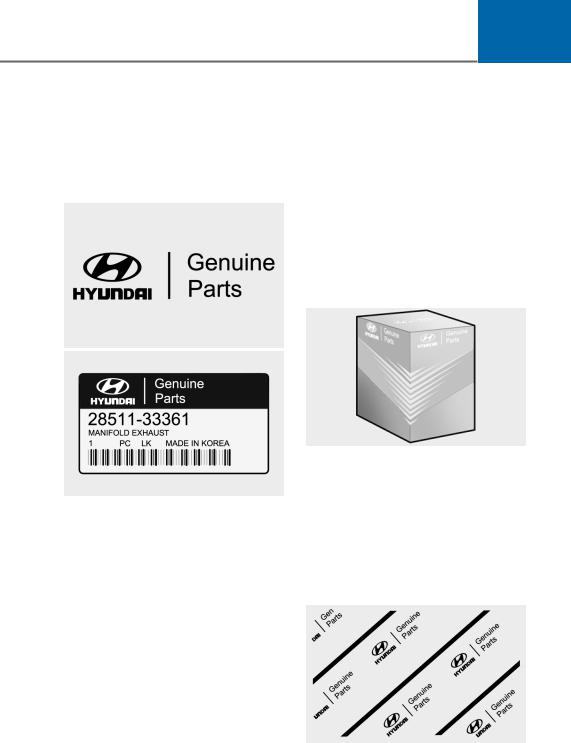
01
GUIDE TO HYUNDAI GENUINE PARTS
1.What are HYUNDAI Genuine Parts?
HYUNDAI Genuine Parts are the same parts used by HYUNDAI Motor Company to manufacture vehicles. They are designed and tested for the optimum safety, performance, and reliability for our customers.
2.Why Hyundai Genuine Parts?
HYUNDAI Genuine Parts are engineered and built to meet rigid manufacturing requirements. Damage caused by using imitation, counterfeit or used salvage parts is not covered under the HYUNDAI New Vehicle Limited Warranty or any other HYUNDAI warranty.
In addition, any damage to or failure of HYUNDAI Genuine Parts caused by the installation or failure of an imitation, counterfeit or used salvage part is not covered by any HYUNDAI Warranty.
3.How can you tell if you are purchasing HYUNDAI Genuine Parts?
Look for the HYUNDAI Genuine Parts Logo on the package (see below).
HYUNDAI Genuine Parts exported to the U.S. are packaged with labels written only in English.
HYUNDAI Genuine Parts are only sold through authorized HYUNDAI Dealerships.
1-3

Foreword
HOW TO USE THIS MANUAL
We want to help you get the greatest possible driving pleasure from your vehicle. Your Owner’s Manual can assist you in many ways. To gain an overview of the contents of your Owner’s Manual, use the Table of Contents in the front of the manual. The first page of each Chapter includes a detailed Table of Contents of the topics in that Chapter.
To quickly locate information about your vehicle, use the Index in the back of the manual. It is an alphabetical list of what is in this manual and the page number where it can be found.
For your convenience, we have incorporated tabs on the right-hand page edges. These tabs are coded with the Chapter titles to assist you with navigating through the manual.
SAFETY MESSAGES
Your safety, and the safety of others, is very important. This Owner’s Manual provides you with many safety precautions and operating procedures. This information alerts you to potential hazards that may hurt you or others, as well as cause damage to your vehicle.
Safety messages found on vehicle labels and in this manual describe these hazards and what to do to avoid or reduce the risks.
Warnings and instructions contained in this manual are for your safety. Failure to follow safety warnings and instructions can lead to serious injury or death.
1-4

Throughout this manual DANGER, WARNING, CAUTION, NOTICE and the
ALERT SYMBOL will be used.
This is the safety alert symbol. It is used to alert you to potential physical injury hazards. Obey all safety messages that follow this symbol to avoid possible injury or death. The safety alert symbol precedes the signal words DANGER, WARNING and CAUTION.
DANGER
DANGER indicates a hazardous which, if not avoided, will
in death or serious injury.
WARNING
WARNING indicates a hazardous which, if not avoided, could
in death or serious injury.
CAUTION
CAUTION indicates a hazardous situation which, if not avoided, could result in minor or moderate injury.
NOTICE
NOTICE indicates a situation which, if not avoided, could result in vehicle damage.
01
FUEL REQUIREMENTS
Your new vehicle is designed to obtain maximum performance with UNLEADED FUEL, as well as minimize exhaust emissions and spark plug fouling.
Your new vehicle is designed to use only unleaded fuel having an octane number ((R+M)/2) of 87 (Research Octane Number 91) or higher. (Do not use methanol blended fuels)
NOTICE
To prevent damage to the engine and engine components, never add any fuel system cleaning agents to the fuel tank other than what has been specified.
an authorized HYUNDAI dealer information.
WARNING
•Do not “top off” after the nozzle automatically shuts off when refueling.
•Always check that the fuel cap is installed securely to prevent fuel spillage in the event of an accident.
1-5

Foreword
Gasoline containing alcohol or methanol
Gasohol, a mixture of gasoline and ethanol (also known as grain alcohol) are being marketed along with or instead
of leaded or unleaded gasoline. For example, “E15” is a gasohol comprised of 15% ethanol and 85% gasoline.
Do not use gasohol containing more than 15% ethanol, and do not use gasoline or gasohol containing any methanol. Either of these fuels may cause drivability problems and damage to the fuel system, engine control system and emission control system.
Discontinue using gasohol of any kind if drivability problems occur.
“E85” fuel is an alternative fuel comprised of 85 percent ethanol and 15 percent gasoline, and is manufactured exclusively for use in Flexible Fuel Vehicles. “E85” is not compatible with your vehicle. Use of “E85” may result in poor engine performance and damage to your vehicle’s engine and fuel system. HYUNDAI recommends that customers do not use fuel with an ethanol content exceeding 15 percent.
NOTICE
To prevent damage to your vehicle’s engine and fuel system:
•Never use gasohol which contains methanol.
•Never use gasohol containing more than 15% ethanol.
•Never use leaded fuel or leaded gasohol.
•Never use “E85” fuel.
Your New Vehicle Limited Warranty does not cover damage to the fuel system or any performance problems caused by the use of “E85” fuel.
Using Fuel Additives (except Detergent Fuel Additives)
Using fuel additives such as: -- Silicone fuel additive
-- Ferrocene (iron-based) fuel additive -- Other metallic-based fuel additives
may result in cylinder misfire, poor acceleration, engine stalling, damage to the catalyst, or abnormal corrosion, and may cause damage to the engine resulting in a reduction in the overall life of the powertrain.
-- The Malfunction Indicator Lamp (MIL) may illuminate.
NOTICE
Damage to the fuel system or performance problem caused by the use of these fuels or fuel additives may not be covered by your New Vehicle Limited Warranty.
Gasoline containing MMT
Some gasoline contains harmful manganese-based fuel additives such as MMT (Methylcyclopentadienyl Manganese Tricarbonyl).
HYUNDAI does not recommend the use of gasoline containing MMT.
This type of fuel can reduce vehicle performance and affect your emission control system.
The malfunction indicator lamp on the cluster may come on.
1-6

Detergent Fuel Additives
HYUNDAI recommends that you use good quality gasolines treated with detergent additives such as TOP TIER Detergent Gasoline, which help prevent deposit formation in the engine. These gasolines will help the engine run cleaner and enhance performance of the Emission Control System. For more information on TOP TIER Detergent Gasoline, please go to the website (www. toptiergas.com).
For customers who do not use TOP Tier Detergent Gasoline regularly, and have problems starting or the engine does not run smoothly, detergent-based fuel additives that you can purchase
separately may be added to the gasoline. If TOP TIER Detergent Gasoline is
not available, one bottle of additive added to the fuel tank according to the maintenance schedule is recommended (refer to the Maintenance Schedule in chapter 8).
Additives are available from your authorized HYUNDAI dealer along with information on how to use them. Do not mix other additives.
Operation in foreign countries
If you are going to drive your vehicle in another country, be sure to:
•Observe all regulations regarding registration and insurance.
•Determine that acceptable fuel is available.
01
VEHICLE MODIFICATIONS
•This vehicle should not be modified. Modification of your vehicle could affect its performance, safety or durability and may even violate governmental safety and emissions regulations.
In addition, damage or performance problems resulting from any modification may not be covered under warranty.
•If you use unauthorized electronic devices, it may cause the vehicle to operate abnormally, wire damage, battery discharge and fire. For your safety, do not use unauthorized electronic devices.
VEHICLEBREAK-IN
PROCESS
By following a few simple precautions for the first 600 miles (1,000 km) you may add to the performance, economy and life of your vehicle.
•Do not race the engine.
•While driving, keep your engine speed (rpm, or revolutions per minute) between 2,000 rpm and 4,000 rpm.
•Do not maintain a single speed for long periods of time, either fast or slow. Varying engine speed is needed to properly break-in the engine.
•Avoid hard stops, except in emergencies, to allow the brakes to seat properly.
1-7

Foreword
 WARNING
WARNING
CALIFORNIA PROPOSITION 65 WARNING
Items contained in motor vehicles or emitted from them are known to the State of California to cause cancer and birth defects or reproductive harm. These include:
•Gasoline and its vapors
•Engine exhaust
•Used engine oil
•Interior passenger compartment components and materials
•Component parts which are subject to heat and wear
In addition, battery posts, terminals and related accessories contain lead, lead compounds and other chemicals known to the State of California to cause cancer and reproductive harm.
For more information go to https://www.p65warnings.ca.gov/ passenger-vehicle
VEHICLE DATA COLLECTION AND EVENT DATA RECORDERS
This vehicle is equipped with an event data recorder (EDR). The main purpose of an EDR is to record, in certain crash or near crash-like situations, such as an air bag deployment or hitting a road obstacle, data that will assist in understanding how a vehicle’s systems performed. The EDR is designed to record data related to vehicle dynamics and safety systems for a short period of time, typically 30 seconds or less. The
EDR in this vehicle is designed to record such data as:
•How various systems in your vehicle were operating;
•Whether or not the driver and passenger safety belts were buckled/ fastened;
•How far (if at all) the driver was depressing the accelerator and/or brake pedal; and,
•How fast the vehicle was traveling.
This data can help provide a better understanding of the circumstances in which crashes and injuries occur. NOTE: EDR data is recorded by your vehicle only if a non-trivial crash situation occurs; no data is recorded by the EDR under normal driving conditions and no personal data (e.g., name, gender, age, and crash location) are recorded. However, other parties, such as law enforcement, could combine the
EDR data with the type of personally identifying data routinely acquired during a crash investigation.
To read data recorded by an EDR, special equipment is required, and access to the vehicle or the EDR is needed. In addition to the vehicle manufacturer, other parties, such as law enforcement, that have the special equipment, can read the information if they have access to the vehicle or the EDR.
1-8
2. Vehicle Information
|
|
|
|
...........................................................................................Exterior Overview |
2-2 |
|
|
Interior Overview............................................................................................ |
2-4 |
|
|
Instrument Panel Overview........................................................................... |
2-5 |
|
|
Engine Compartment..................................................................................... |
2-6 |
|
|
Dimensions...................................................................................................... |
2-7 |
|
|
2 |
|||
Engine Specification....................................................................................... |
2-7 |
||
Bulb Wattage.................................................................................................. |
2-8 |
|
|
|
|||
Tires and Wheels............................................................................................ |
2-9 |
|
|
Volume and Weight....................................................................................... |
2-10 |
|
|
Air Conditioning System............................................................................... |
2-10 |
|
|
Recommended Lubricants and Capacities.................................................. |
2-11 |
|
|
Recommended SAE Viscosity Number.................................................................. |
2-12 |
|
|
Vehicle Identification Number (VIN)............................................................ |
2-13 |
|
|
Vehicle Certification Label............................................................................ |
2-13 |
|
|
Tire Specification and Pressure Label.......................................................... |
2-14 |
|
|
Engine Number.............................................................................................. |
2-14 |
|
|
Refrigerant Label .......................................................................................... |
2-15 |
|

Vehicle Information
EXTERIOR OVERVIEW
Front view
The actual shape may differ from the illustration.
|
|
|
|
|
ODN8A019001 |
1. |
Hood ...................................................... |
5-64 |
5. |
Panoramic sunroof ............................... |
5-60 |
2. |
Headlamp.............................................. |
8-55 |
6. |
Front windshield wiper blades ............ |
8-29 |
3. |
Tires and wheels ................................... |
8-34 |
7. |
Windows................................................ |
5-56 |
4. |
Side view mirror................................... |
5-53 |
|
|
|
2-2
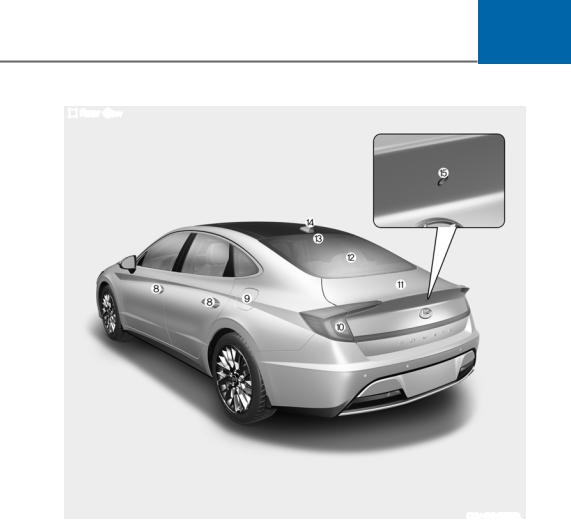
02
Rear view
The actual shape may differ from the illustration.
|
|
|
|
|
ODN8019002L |
8. |
Door handle............................................ |
5-31 |
12. |
Defroster............................................... |
5-142 |
9. |
Fuel filler door....................................... |
5-70 |
13. |
High mounted stop lamp...................... |
8-58 |
10. Rear tail lamp........................................ |
8-56 |
14. |
Antenna................................................. |
5-152 |
|
11. |
Trunk...................................................... |
5-65 |
15. |
Rear view camera................................. |
5-86 |
2-3

Vehicle Information
INTERIOR OVERVIEW
The actual shape may differ from the illustration.
ODN8A019003
1. |
Inside door handle................................ |
5-32 |
2. |
Seat position memory system.............. |
5-39 |
3. |
Side view mirror control switch........... |
5-54 |
4. |
Central door lock switch ....................... |
5-33 |
5. |
Power window switches....................... |
5-56 |
6. |
Power window lock button................... |
5-59 |
7. |
Steering wheel tilt/telescopic lever..... |
5-43 |
8. |
Steering wheel...................................... |
5-42 |
9. |
Instrument panel illumination control |
|
|
switch....................................................... |
4-3 |
10. Idle Stop and Go (ISG) OFF button...... |
6-33 |
|
11. |
Lane Keeping Assist system button..... |
6-58 |
12. |
Trunk release button............................. |
5-65 |
13. |
ESC OFF button..................................... |
6-29 |
14. |
EPB (Electronic Parking Brake).............. |
6-21 |
15. |
Hood release lever ............................... |
5-64 |
2-4

02
INSTRUMENT PANEL OVERVIEW
The actual shape may differ from the illustration.
ODN8019005
1. |
Instrument cluster................................... |
4-2 |
2. |
Driver’s front air bag............................. |
3-39 |
3. |
Key ignition switch/ ............................... |
6-6 |
|
Engine Start/Stop button....................... |
6-9 |
4. |
Audio / Video / Navigation system..... |
5-154 |
5. |
Hazard warning flasher switch................ |
7-2 |
6. |
Manual climate control system/.......... |
5-118 |
|
Automatic climate control system...... |
5-127 |
7. |
Passenger’s front air bag...................... |
3-39 |
8. |
Glove box.............................................. |
5-144 |
9. |
Transmission shift button...................... |
6-13 |
10. Reverse Parking Distance |
|
Warning/................................................ |
5-95 |
Forward/Reverse Parking Distance |
|
Warning system button........................ |
5-99 |
11.Surround View Monitor system button 5-88
12.Drive mode integrated control system 6-37
13. AUTO HOLD........................................... |
6-24 |
14. Remote Smart Parking Assist (RSPA) |
|
system button...................................... |
5-104 |
2-5

Vehicle Information
ENGINE COMPARTMENT
Smartstream G1.6 T -GDi
-GDi
Smartstream G2.5 GDi
The actual engine room in the vehicle may differ from the illustration.
|
|
|
|
ODN8089103/ ODN8089048L |
|
1. |
Engine coolant reservoir |
........................ 8-21 |
5. |
Engine oil filler cap................................. |
8-19 |
2. |
Brake fluid reservoir.............................. |
8-24 |
6. |
Windshield washer fluid reservoir........ |
8-25 |
3. |
Air cleaner.............................................. |
8-26 |
7. |
Fuse box................................................. |
8-46 |
4. |
Engine oil dipstick................................. |
8-19 |
8. |
Battery.................................................... |
8-31 |
2-6

02
DIMENSIONS
|
Items |
in. (mm) |
||
Overall length |
|
|
|
|
|
|
192.9 (4,900) |
||
|
|
|
|
|
Overall width |
|
|
73.2 (1,860) |
|
|
|
|
|
|
Overall height |
|
|
56.9 (1,445) |
|
|
|
|
|
|
|
|
205/65 R16 |
64.3 |
(1,633) |
|
|
|
|
|
Front tread |
|
215/55 R17 |
63.9 |
(1,623) |
|
|
|
|
|
|
|
235/45 R18 |
63.7 |
(1,618) |
|
|
|
|
|
|
|
205/65 R16 |
64.6 (1,640) |
|
|
|
|
|
|
Rear tread |
|
215/55 R17 |
64.2 (1,630) |
|
|
|
|
|
|
|
|
235/45 R18 |
64.0 |
(1,625) |
|
|
|
|
|
Wheelbase |
|
|
111.8 (2,840) |
|
|
|
|
|
|
ENGINE SPECIFICATION
Item |
|
|
Smartstream G1.6 T-GDi |
|
Smartstream G2.5 GDi |
Displacement |
cu. in. (cc) |
|
97.08 (1,591) |
|
152.37 (2,497) |
|
|
||||
|
|
|
|||
|
|
|
|
|
|
Bore x Stroke |
in. (mm) |
|
3.03 x 3.06 (77 x 85.44) |
|
3.47 x 4.00 (88.5 x 101.5) |
|
|
|
|||
|
|
|
|
|
|
Firing order |
|
|
1-3-4-2 |
|
1-3-4-2 |
|
|
|
|
|
|
No. of cylinders |
|
|
4, in-line |
|
4, in-line |
|
|
|
|
|
|
2-7
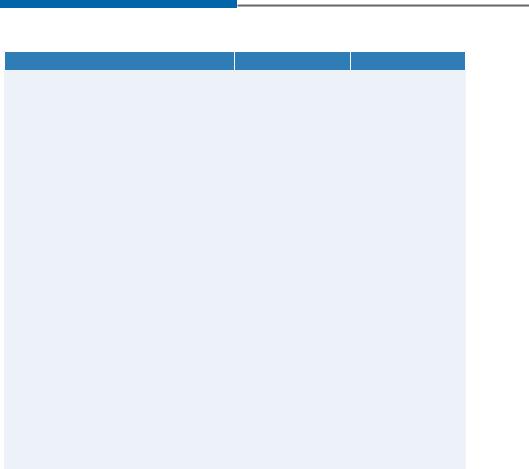
Vehicle Information
BULB WATTAGE
|
Light bulb |
Bulb type |
Wattage |
||
|
|
|
|
|
|
|
Headlamp (High/Low) |
LED |
LED |
||
|
|
|
|
|
|
|
Daytime running lamp (DRL)/ |
LED |
LED |
||
|
Position lamp |
||||
Front |
|
|
|||
Turn signal lamp |
LED |
LED |
|||
|
|||||
|
|
|
|
|
|
|
Side repeater lamp |
LED |
LED |
||
|
(Outside mirror) |
||||
|
|
|
|||
|
Stop lamp |
Bulb type |
PY21W |
21 |
|
|
|
|
|
||
|
LED type |
LED |
LED |
||
|
|
||||
|
|
|
|
|
|
|
Tail lamp |
LED |
LED |
||
Rear |
|
|
|
|
|
Turn signal lamp |
LED |
LED |
|||
|
|
|
|
|
|
|
Back up Lamp |
W16W |
16 |
||
|
|
|
|
|
|
|
High mounted stop lamp |
LED |
LED |
||
|
|
|
|
|
|
|
License plate lamp |
W5W |
5 |
||
|
|
|
|
|
|
|
Map lamp |
Type A |
WEDGE |
10 |
|
|
|
|
|
||
|
Type B |
LED |
LED |
||
|
|
||||
|
|
|
|
|
|
Interior |
Personal lamp (if equipped) |
LED |
LED |
||
|
|
|
|
||
Room lamp (if equipped) |
FESTOON |
10 |
|||
|
|||||
|
|
|
|
|
|
|
Vanity mirror lamp |
FESTOON |
5 |
||
|
|
|
|
|
|
|
Luggage compartment lamp |
FESTOON |
5 |
||
|
|
|
|
|
|
2-8
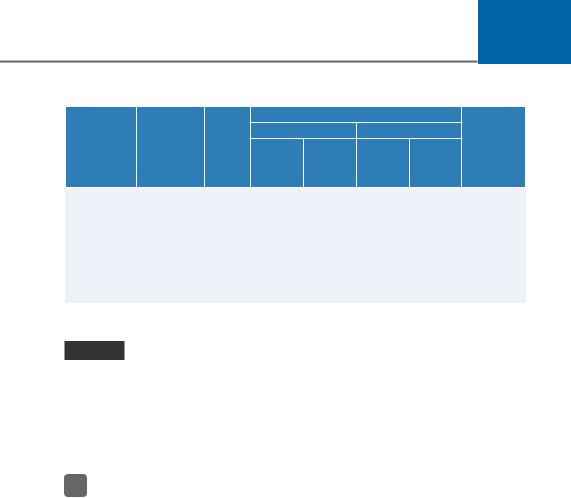
02
TIRES AND WHEELS
|
|
|
|
|
Inflation pressure kPa (psi) |
Wheel lug |
||||||
|
|
|
|
|
Normal load *1 |
|
Maximum load |
|||||
|
|
|
Wheel |
|
|
nut torque |
||||||
Item |
Tire Size |
|
|
|
|
|
|
|
|
|
||
|
|
|
|
|
|
|
|
|
kgf·m |
|||
|
Size |
|
|
|
|
|
|
|
|
|||
|
|
|
|
Front |
|
Rear |
|
Front |
|
Rear |
(lbf·ft, |
|
|
|
|
|
|
|
|
|
|||||
|
|
|
|
|
|
|
|
|
|
|
|
N·m) |
|
205/65 R16 |
|
6.5Jx16 |
|
240 (35) |
|
240 (35) |
|
240 (35) |
|
240 (35) |
|
|
|
|
|
|
|
|
||||||
Full size tire |
215/55 R17 |
|
7.0Jx17 |
|
240 (35) |
|
240 (35) |
|
240 (35) |
|
240 (35) |
|
|
235/45 R18 |
|
7.5Jx18 |
|
240 (35) |
|
240 (35) |
|
240 (35) |
|
240 (35) |
11~13 |
|
|
|
|
|
|
|
|
|
|
|
|
|
Compact |
T125/80 D16 |
|
4Tx16 |
|
420 (60) |
|
420 (60) |
|
420 (60) |
|
420 (60) |
(79~94, |
|
|
|
|
|
|
|
|
|
|
|
107~127) |
|
|
|
|
|
|
|
|
|
|
|
|
||
spare tire |
T135/80 D17 |
|
4Tx17 |
|
420 (60) |
|
420 (60) |
|
420 (60) |
|
420 (60) |
|
(if equipped) |
|
|
|
|
|
|
|
|
|
|
|
|
T135/80 D18 |
|
4Tx18 |
|
420 (60) |
|
420 (60) |
|
420 (60) |
|
420 (60) |
|
|
|
|
|
|
|
|
|
|
|
|
|
|
|
*1 : Normal load: Up to 3 persons
NOTICE
•It is permissible to add 3 psi to the standard tire pressure specification if colder temperatures are expected soon.
Tires typically lose 1psi (7kPa) for every 12°F temperature drop. If extreme temperature variations are expected, recheck your tire pressure as necessary to keep them properly inflated.
•Tire inflation pressures will vary with changes in elevation. If driving in areas of higher or lower elevation, be sure to check and adjust for proper tire inflation.
 CAUTION
CAUTION
•When replacing tires, use the same size originally supplied with the vehicle. Using tires of a different size can damage the related parts or not work properly.
•When replacing tires, ALWAYS use the same size, type, construction and tread pattern supplied with the vehicle for all tires.
2-9
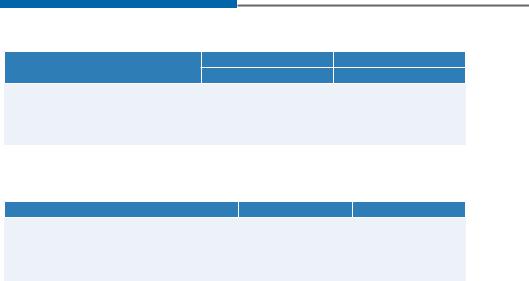
Vehicle Information
VOLUME AND WEIGHT
Items |
|
Smartstream G1.6 T-GDi |
Smartstream G2.5 GDi |
|
|
|
A/T |
A/T |
|
|
|
|
||
Gross vehicle weight |
lbs. (kg) |
|
4354 (1975) |
|
|
|
|||
|
|
|
|
|
Luggage volume (SAE) |
cu ft (ℓ) |
|
16 (453) |
|
|
|
|||
|
|
|
|
|
A/T : Automatic Transmission |
|
|
|
|
AIR CONDITIONING SYSTEM |
|
|
||
|
Item |
Weight of Volume |
Classification |
Refrigerant |
Smartstream G1.6 T-GDi |
17.6±0.88 (500±25) |
R-1234yf |
oz. (g) |
Smartstream G2.5 GDi |
18.3±0.88 (520±25) |
R-1234yf |
Compressor lubricant |
32.8±0.35 (80±10) |
PAG (FD46XG) |
|
|
oz. (g) |
||
|
|
|
|
Contact an authorized HYUNDAI dealer for more details. |
|
||
2-10

02
RECOMMENDED LUBRICANTS AND CAPACITIES
To help achieve proper engine and powertrain performance and durability, use only lubricants of the proper quality. The correct lubricants also help promote engine efficiency that results in improved fuel economy.
These lubricants and fluids are recommended for use in your vehicle.
Lubricant |
Volume |
Classification |
||
Engine oil *1 *2 |
|
Smartstream |
|
|
|
|
|
||
(drain and refill) |
|
4.76 US qt. (4.5 ℓ) |
API Lastest (SN PLUS) *3 |
|
|
G1.6 T-GDi |
|||
|
|
|
|
|
|
|
|
|
|
|
|
Smartstream |
5.49 US qt. (5.2 ℓ) |
API Lastest (SN PLUS) *3 |
|
|
G2.5 GDi |
||
|
|
|
|
|
|
|
|
|
|
|
|
|
|
MICHANG ATF SP-IV, SK ATF SP IV, |
|
|
|
|
NOCA ATF SP-IV, S-oil ATF SP-IV |
Automatic transmission fluid |
6.89 US qt. (6.5ℓ) |
HYUNDAI genuine ATF SP-IV |
||
|
|
|
|
or other brands meeting the |
|
|
|
|
above specification approved by |
|
|
|
|
HYUNDAI Motor Co. |
|
|
Smartstream |
4.76 US qt. (4.5 ℓ) |
Mixture of antifreeze and distilled |
Coolant |
|
G1.6 T-GDi |
||
|
|
water (Ethylene glycol base |
||
|
Smartstream |
|
||
|
|
5.49 US qt. (5.2 ℓ) |
coolant for aluminum radiator) |
|
|
|
G2.5 GDi |
||
|
|
|
|
|
Brake fluid *4 |
|
|
0.74 ~ 0.85 US qt. |
DOT-4 |
|
|
|
(0.7 ~ 0.8 ℓ) |
|
|
|
|
15.85 US gal. (60 ℓ) |
|
Fuel |
|
|
14.79 US gal. (56 ℓ) |
Refer to “Fuel requirements” in |
|
|
(for ECO package |
chapter 1. |
|
|
|
|
||
|
|
|
model) |
|
*1 :
*2 :
*3 :
*4 :
Refer to the recommended SAE viscosity numbers on page 12.
Engine oils labeled Energy Conserving Oil are now available. Along with other additional benefits, they contribute to fuel economy by reducing the amount of fuel necessary
to overcome engine friction. Often, these improvements are difficult to measure in everyday driving, but in a year’s time, they can offer significant cost and energy savings.
If the recommended engine oil is not available in your country, you are able to use API SL/ILSAC GF-3 or ACEA A3.
To maintain the best braking performance and ABS/ESC performance, we recommend that you use genuine brake fluid that conform to specifications. (Standard : SAE J1704 DOT-4 LV, ISO4925 CLASS-6 and FMVSS 116 DOT-4)
2-11

Vehicle Information
Recommended SAE Viscosity
Number
 CAUTION
CAUTION
Always be sure to clean the area around any filler plug, drain plug, or dipstick before checking or draining any lubricant. This is especially important in dusty or sandy areas and when the vehicle is used on unpaved roads. Cleaning the plug and dipstick areas will prevent dirt and grit from entering the engine and other mechanisms that could be damaged.
Engine oil viscosity (thickness) has an effect on fuel economy and cold weather operating (engine start and engine oil flowability). Lower viscosity engine oils can provide better fuel economy and cold weather performance, however, higher viscosity engine oils are required for satisfactory lubrication in hot weather.
Using oils of any viscosity other than those recommended could result in engine damage.
When choosing an oil, consider the range of temperature your vehicle will be operated in before the next oil change. Proceed to select the recommended oil viscosity from the chart.
Temperature Range for SAE Viscosity Numbers
Temperature |
°C |
-30 -20 |
-10 |
0 |
10 |
20 |
30 |
40 |
50 |
||
(°F) |
-10 0 |
20 |
40 |
60 |
|
|
80 |
100 |
120 |
||
|
|
|
|||||||||
|
|
|
|
|
|
|
|
|
|
|
|
Engine Oil |
|
|
|
|
|
10W-30 |
|
|
|
|
|
|
|
|
|
|
|
|
|
|
|
|
|
|
|
|
|
|
|
|
|
|
|
|
|
|
|
|
|
0/5W-20, 0/5W-30 |
|
|
|
|
|
||
|
|
|
|
|
|
|
|
|
|
|
|
*1 : For better fuel economy, it is recommended to use the engine oil of a viscosity grade 0W-20 (API Latest
(SN PLUS)). However, if the engine oil is not available in your country, select the proper engine oil using the engine oil viscosity chart.
2-12

VEHICLE IDENTIFICATION
NUMBER(VIN)
Frame number
ODN8019020
The vehicle identification number (VIN) is the number used in registering your car and in all legal matters pertaining to its ownership, etc.
The number is punched on the floor under the passenger seat.
VIN label
ODN8019026L
The VIN is also on a plate attached to the top of the dashboard. The number on the plate can easily be seen through the windshield from outside.
02
VEHICLE CERTIFICATION LABEL
ODN8019021
The vehicle certification label attached on the driver’s side center pillar gives the Vehicle Identification Number (VIN).
2-13

Vehicle Information
|
|
|
TIRE SPECIFICATION AND |
|
ENGINE NUMBER |
PRESSURE LABEL |
|
|
ODN8H019025L
The tires supplied on your new vehicle are chosen to provide the best performance for normal driving.
The tire label located on the driver’s side center pillar gives the tire pressures recommended for your car.
ODN8019022
The engine number is stamped on the engine block as shown in the drawing.
2-14
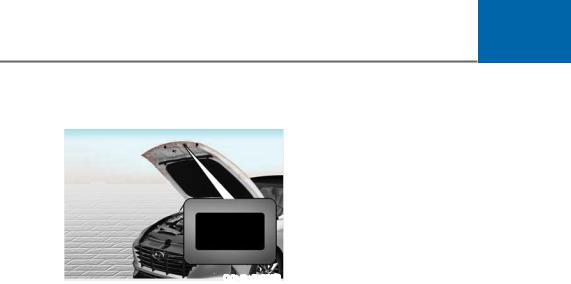
02
REFRIGERANT LABEL
(IFEQUIPPED)
ODN8A079026
The refrigerant label provides information such as refrigerant type and amount. (R-1234yf)
2-15

3.Seats & Safety System
This chapter provides you with important information about how to protect yourself and your passengers. It explains how to properly use your seats and seat belts, and how your air bags work. Additionally, this chapter explains how to properly restrain infants and children in your vehicle.
Important Safety Precautions ....................................................................... |
3-2 |
Always Wear Your Seat Belt..................................................................................... |
3-2 |
Restrain All Children................................................................................................. |
3-2 |
Air Bag Hazards ........................................................................................................ |
3-2 |
Driver Distraction ..................................................................................................... |
3-2 |
Control Your Speed .................................................................................................. |
3-2 |
Keep Your Vehicle in Safe Condition....................................................................... |
3-2 |
Seats ............................................................................................................... |
3-3 |
|
|
3 |
|||
Safety Precautions ................................................................................................... |
3-4 |
||
Front Seats................................................................................................................ |
3-5 |
||
Rear Seats ................................................................................................................ |
3-10 |
|
|
|
|||
Head Restraints ........................................................................................................ |
3-11 |
|
|
Seat Warmers and Air Ventilation Seats ................................................................ |
3-15 |
|
|
Seat Belts....................................................................................................... |
3-19 |
|
|
Seat Belt Safety Precautions .................................................................................. |
3-19 |
|
|
Seat Belt Warning Light ......................................................................................... |
3-20 |
|
|
Seat Belt Restraint System ..................................................................................... |
3-21 |
|
|
Additional Seat Belt Safety Precautions ............................................................... |
3-26 |
|
|
Care of Seat Belts................................................................................................... |
3-28 |
|
|
Child Restraint System (CRS)...................................................................... |
3-29 |
|
|
Children Always in the Rear................................................................................... |
3-29 |
|
|
Selecting a Child Restraint System (CRS)............................................................. |
3-30 |
|
|
Installing a Child Restraint System (CRS) .............................................................. |
3-31 |
|
|
Air Bag - Advanced Supplemental Restraint System ................................ |
3-37 |
|
|
Where Are the Air Bags? ........................................................................................ |
3-39 |
|
|
How Does the Air Bag System Operate?............................................................... |
3-42 |
|
|
What to Expect After an Air Bag Inflates .............................................................. |
3-46 |
|
|
Occupant Classification System (OCS)................................................................. |
3-47 |
|
|
Why Didn’t My Air Bag Go Off in a Collision? ....................................................... |
3-52 |
|
|
SRS Care ................................................................................................................. |
3-56 |
|
|
Additional Safety Precautions ............................................................................... |
3-57 |
|
|
Air Bag Warning Labels.......................................................................................... |
3-57 |
|

Seats & Safety System
IMPORTANT SAFETY PRECAUTIONS
You will find many safety precautions and recommendations throughout this section, and throughout this manual. The safety precautions in this section are among the most important.
Always Wear Your Seat Belt
A seat belt is your best protection in all types of accidents. Air bags are designed to supplement seat belts, not replace them. So even though your vehicle is equipped with air bags, ALWAYS make sure you and your passengers wear your seat belts, and wear them properly.
Restrain All Children
All children under age 13 should ride in your vehicle properly restrained in a
rear seat, not the front seat. Infants and small children should be restrained in an appropriate child restraint. Larger children should use a booster seat with the lap/shoulder belt until they can use the seat belt properly without a booster seat.
Air Bag Hazards
While air bags can save lives, they can also cause serious or fatal injuries to occupants who sit too close to them, or who are not properly restrained. Infants, young children, and shorter adults are at the greatest risk of being injured by an inflating air bag. Follow all instructions and warnings in this manual.
Driver Distraction
Driver distraction presents a serious and potentially deadly danger, especially for inexperienced drivers. Safety should be the first concern when behind the wheel, and drivers need to be aware of the wide array of potential distractions, such as drowsiness, reaching for objects, eating, personal grooming, other passengers, and using cellular phones.
Drivers can become distracted when they take their eyes and attention off the road or their hands off the wheel to focus on activities other than driving. To reduce your risk of distraction or getting into an accident:
•ALWAYS set up your mobile devices (i.e., MP3 players, phones, navigation units, etc.) when your vehicle is parked or safely stopped.
•ONLY use your mobile device when allowed by laws and when conditions permit safe use. NEVER text or email while driving. Most states have laws prohibiting drivers from texting. Some states and cities also prohibit drivers from using handheld phones.
•NEVER let the use of a mobile device distract you from driving. You have a responsibility to your passengers and others on the road to always drive safely, with your hands on the wheel as well as your eyes and attention on the road.
Control Your Speed
Excessive speed is a major factor in crash injuries and deaths. Generally, the higher the speed, the greater the risk, but serious injuries can also occur at lower speeds. Never drive faster than is safe for current conditions, regardless of the maximum speed posted.
Keep Your Vehicle in Safe Condition
Having a tire blowout or a mechanical failure can be extremely hazardous. To reduce the possibility of such problems, check your tire pressures and condition frequently, and perform all regularly scheduled maintenance.
3-2
